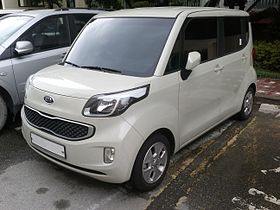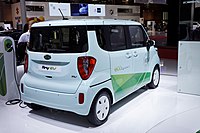Kia Ray
| Kia Ray | |
|---|---|
 | |
| Overview | |
| Manufacturer | Kia |
| Production | 2011–present |
| Assembly | South Korea: Seosan Plant, Seosan (Donghee) |
| Body and chassis | |
| Class | City car (A) |
| Body style | 5-door minivan |
| Layout | Front-engine, front-wheel-drive |
| Platform | Hyundai-Kia SA |
| Related | Kia Picanto (TA) |
| Powertrain | |
| Engine | 1.0 L Kappa II I3 (petrol) 1.0 L Kappa II TCI I3 (petrol) 1.0 L Kappa II I3 (petrol/LPG) 1.0 L Kappa II I3 (LPG) |
| Electric motor | 50 kW (67 hp) |
| Transmission | 4-speed A4CF0 automatic CVT |
| Battery | 16.4 kWh lithium ion battery |
| Range | 138 km (86 mi) |
| Dimensions | |
| Wheelbase | 2,520 mm (99.2 in) |
| Length | 3,595 mm (141.5 in) |
| Width | 1,595 mm (62.8 in) |
| Height | 1,700 mm (66.9 in) |
| Curb weight | 988–1,110 kg (2,178–2,447 lb) |
The Kia Ray is a city car manufactured by Kia exclusively for the South Korean domestic market. Based on the Kia Picanto/Morning, it was specifically developed in compliance with the "light car" (Korean: 경차, romanized: Gyeongcha) category that offers tax incentives for cars with exterior dimensions below 3,600 mm (141.7 in) in length and below 1,600 mm (63.0 in) in width.[1]
Overview[]
The initial roll out was a limited production of 2,500 units destined for the South Korean government fleets, scheduled to be deployed in 2012. The Kia Ray EV was a predecessor to an all-electric crossover SUV that, as of 2011, Kia had planned to launch globally in 2014.[2] In May 2013 a fleet of 184 Kia Ray EVs were deployed in Seoul as part of a carsharing service called "Electric Vehicle Sharing” at a rate of US$5 per hour. The service had 15,000 registered customers by May 2013.[3][needs update]
The Ray has a unique door layout; the passenger side of the vehicle has a sliding door for the rear seats, while the driver's side has a swing-out door.[4] The car has a kei car-inspired boxy dimensions. The Ray's interior benefits from the square shape, as it has more space than most cars its size; however, it is only able to seat four people.
The Ray EV is the Kia's first production battery electric vehicle. It is powered by a 50 kW (67 hp) electric motor, with a 16.4 kWh lithium ion battery that allows an all-electric range of 138 km (86 mi) depending on driving conditions.[5][needs update]
The Ray is also available in non-EV types equipped with gasoline and bi-fuel with a gasoline and liquefied petroleum gas (LPG) combination.[citation needed] Both engines are available in four trims - Deluxe, Special, Luxury and Prestige. Only available in the local Korea domestic market, both engines produce similar power and outputs. The gasoline engine generates 78 PS (57 kW; 77 hp) at 6,400 rpm and 9.6 kg.m/3,500 rpm. Both engines have displacements of 998 cc, generating fuel economies of 17 km/l for gasoline, and bi-fuel delivering 16.6 km/l on gasoline mode and 13.2 km/l on LPG mode. Gasoline engine models weigh in at 998 kg (2,200 lb) with bi-fuel models weighing in at 1,042 kg (2,297 lb). Both are equipped with a 4 speed automatic transmission, and are currently sold in the Republic of Korea.[citation needed]
Facelift[]
The Ray received a facelift for the 2018 model year. Changes consist of a new front end design with a closed grill and a revised interior.[4]
Gallery[]
Kia Ray EV (front)

Kia Ray EV (rear)

Right side featuring sliding rear door

Interior

Facelift (front)

Facelift (rear)
References[]
- ^ "기아 모닝 레이 | 쉐보레 스파크 2021 경차 혜택?". 프리카톡 (in Korean). 2021-01-08. Retrieved 2021-07-17.
- ^ "Kia Introduces Ray EV, We Offer Initial Impressions". Car & Driver. Retrieved 2011-12-22.
- ^ Eric Loveday (2013-05-06). "South Korea Now Offers Electric Vehicle Rentals With Rollout of 184 Kia Ray EVs". InsideEVs.com. Retrieved 2013-06-07.
- ^ Jump up to: a b Sarne, Vernon B. (2019-07-24). "The Kia Ray city car is nice, but can we really afford it?". Visor. Retrieved 2019-07-24.
- ^ "New Kia Ray is Korea's first production EV". Autoblog Green. 2011-12-22. Archived from the original on 2012-01-09. Retrieved 2012-01-06.
External links[]
| Wikimedia Commons has media related to Kia Ray. |
| show |
|---|
- 2010s cars
- Production electric cars
- City cars
- Hatchbacks
- Front-wheel-drive vehicles
- Kia vehicles
- Cars introduced in 2012





